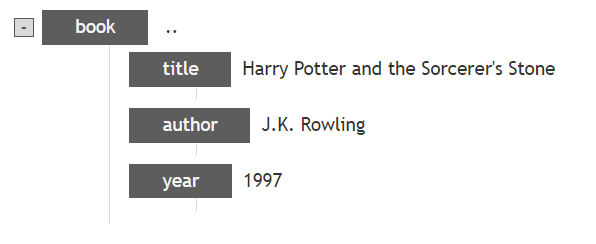What is XML ?
Last Updated :
19 Mar, 2024
Extensible Markup Language (XML) is a type of markup language that establishes a set of guidelines for encoding texts in a way that is both machine- and human-readable. For storing and transferring data on the web and in many other applications, XML is widely used. XML steps in as a versatile tool for encoding and organizing data in a way that both humans and machines can comprehend.

History of XML
XML emerged in the late 1990s as a revolutionary concept in the evolving landscape of the internet. Before XML, HTML served as the predominant language for web content, but it lacked the flexibility needed for complex data representation. XML arrived as a solution, offering a standardized format for expressing diverse types of data in a hierarchical structure.
Different ways of using XML
In the realm of XML, everything revolves around tags. Think of tags as containers that hold different pieces of information. Each tag has a name and can optionally carry attributes, providing additional details about the enclosed data. Here’s a simple breakdown:
<element attribute="value">Text content</element>
Let’s unpack this: <element> represents the name of the container, attribute is like a label describing the container’s contents, and Text content is the actual information stored within the container.
Simple XML Document
<book> acts as the main container, housing details about a book such as its title, author, and publication year.
Example:
<book>
<title>Harry Potter and the Sorcerer's Stone</title>
<author>J.K. Rowling</author>
<year>1997</year>
</book>
XML with Attributes
Here, <student> serves as the container for student information, with attributes like id providing additional identifiers.
Example:
<student id="001">
<name>John Doe</name>
<age>25</age>
<grade>A</grade>
</student>
Example: the <book> element serves as the primary container, encompassing information pertaining to a book such as its title, author, and year of publication.
XML
<book>
<title>Harry Potter and the Sorcerer's Stone</title>
<author>J.K. Rowling</author>
<year>1997</year>
</book>
Output:
Applications of XML
- In the world of web development, XML serves as a handy tool for sorting and moving data around. It’s like the organizer of the digital world, helping to structure everything from news feeds to website maps and setup files. And when it comes to web services like SOAP, XML plays a crucial role in enabling different systems to share information seamlessly over the internet.
- When it comes to exchanging data between different computer systems, XML acts as a kind of universal translator. It bridges the gap between systems that speak different languages, making it possible for businesses and organizations to communicate effectively, even if their software systems don’t normally understand each other.
- Think of XML as a digital filing cabinet for managing documents. It’s used across industries like publishing, healthcare, and law to store and organize documents in a way that’s easy to find and manage. Whether it’s technical manuals or legal documents, XML-based standards like DocBook and DITA provide a structured framework for storing important information.
- Imagine XML as the settings menu of your favorite app. It’s the behind-the-scenes tool that developers use to create organized lists of options and preferences for users to customize their experience. With XML, you can tweak your app settings without needing to know the ins and outs of coding.
- XML is like a shared language between computers and humans. It’s perfect for storing data in databases because it provides a clear and structured way to organize information. And with tools like XML Schema Definition (XSD), you can ensure that your data follows specific rules and formats, making it easier to work with.
- In the world of software integration, XML plays the role of a mediator between different systems. It helps bridge the gap between apps that speak different “languages,” allowing them to communicate and share information seamlessly. This makes it easier for businesses to streamline their operations by connecting all their software systems together.
- And finally, XML has inspired popular data formats like JSON and YAML. These simplified versions of XML are easier for computers to read and write, making them perfect for exchanging data between applications and services. They’re the modern-day equivalents of XML, designed to make data interchange faster and more efficient.
Advantages of XML
- Human-readable: XML’s straightforward tag-based syntax makes it easy for humans to read and understand. This readability promotes collaboration and understanding among developers and other stakeholders.
- Interoperability: Like a skilled interpreter, XML bridges the communication gap between disparate systems, enabling seamless data exchange. Whether it’s sharing data between different applications or integrating systems from different vendors, XML ensures interoperability and compatibility.
- Flexibility: XML’s adaptability allows it to handle a wide range of data types and structures, offering a canvas for expressing diverse information. Whether it’s simple text data, complex hierarchical data, or metadata describing data relationships, XML can accommodate it all.
Limitations of XML
- Verbosity: XML can sometimes be verbose, resembling a verbose storyteller who takes longer to convey information, leading to larger file sizes. This verbosity can impact performance and increase bandwidth usage, especially in scenarios with large datasets or frequent data exchange.
- Complexity: Managing namespaces, schemas, and other XML-related concepts can add layers of complexity, akin to navigating through a maze of rules and conventions. This complexity can be daunting for newcomers and may require additional training and expertise to handle effectively.
- Parsing Overhead: Parsing XML documents can be resource-intensive, especially for large datasets, akin to deciphering a lengthy novel with intricate plot twists. This parsing overhead can impact application performance, particularly in scenarios with real-time data processing or high throughput requirements.
Share your thoughts in the comments
Please Login to comment...